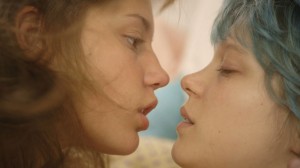 IN the “New Yorker” of October 24, Emily Greenhouse cited actresses Lea Seydoux and Adele Exarchopoulos saying that the shooting of Tunisian film-maker Abdellatif Kechiche’s film had been unbearable.
IN the “New Yorker” of October 24, Emily Greenhouse cited actresses Lea Seydoux and Adele Exarchopoulos saying that the shooting of Tunisian film-maker Abdellatif Kechiche’s film had been unbearable.
Be that as it may, in an unprecedented decision, the 2013 Cannes Film Festival jury chaired by Stephen Spielberg awarded the Palme d’Or to not only Kechiche but also the two actresses. That’s a peer-group provenance to which any film might aspire.
Seydoux plays Emma, studying in a prestigious art school. Exarchopoulos is Adele, still in high school, negotiating the funny things that adolescence can inflict on young women who delight in their bodies without understanding what or why. After seeing Emma in the street, Adele uses the recollection as the stimulus for a successful masturbation. Then she contrives a meeting, setting in motion a relationship that expands during the period between Adele completing school and finding rewarding employment as a teacher.
That may sound a prosaic potted description for a film running for 179 minutes. But in that screen time, visually unabashed sexual love is delineated with marvellous joy and physical fulfilment. For these two women, orgasm is more than an entitlement; it is the threat of an emotional minefield between bouts of love making. And straying with another partner leads to a destructive quarrel of horrendous dimensions.
At Palace Electric
The post Review: ‘Blue is the Warmest Color’ (R) **** appeared first on Canberra CityNews.